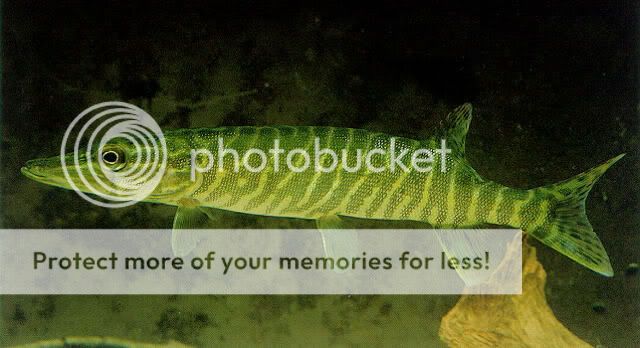- Beranda
- Komunitas
- Hobby
- Freshwater Fish
Esox a.k.a Pike !!!(Ask, Sharing, & Post Your Pike Here!!!!!)
TS
Wyle
Esox a.k.a Pike !!!(Ask, Sharing, & Post Your Pike Here!!!!!)
RATE YA BIAR BINTANGNYA BANYAK

Yg pertama Esox Lucius dulu ya?

Name :Esox Lucius/Northeren Pike
Classification\t
Actinopterygii | Esociformes | Esocidae
Size / Weight / Age
Max length : 137 cm FL male/unsexed; (Ref. 40637); 150 cm TL (female); common length : 40.0 cm TL male/unsexed; (Ref. 556); common length :55 cm TL (female); max. published weight: 28.4 kg (Ref. 40637); max. published weight: 35 kg; max. reported age: 30 years (Ref. 556)
Length at first maturity
Lm 37.6, range 25 - 63 cm
Environment
Demersal; potamodromous; freshwater; brackish; depth range 0 - 30 m (Ref. 1998), usually 1 - 5 m (Ref. 1998)
Climate / Range
Subtropical; 10°C - 28°C (Ref. 12741); 74°N - 36°N, 167°W - 180°E
Distribution
Circumpolar in fresh water. North America: Atlantic, Arctic, Pacific, Great Lakes and Mississippi River basins from Labrador to Alaska and south to Pennsylvania, Missouri and Nebraska, USA (Ref. 5723). Eurasia: Caspian, Black, Baltic, White, Barents, Arctic, North and Aral Seas and Atlantic basins, southwest to Adour drainage; Mediterranean basin in Rhône drainage and northern Italy. Widely distributed in central Asia and Siberia easward to Anadyr drainage (Bering Sea basin). Historically absent from Iberian Peninsula, Mediterranean France, central Italy, southern and western Greece, eastern Adriatic basin, Iceland, western Norway and northern Scotland. Widely introduced and translocated throughout Europe (Ref. 59043). Several countries report adverse ecological impact after introduction (Ref. 1739).
Countries | FAO areas | Ecosystems | Occurrences | Introductions
Short description
Dorsal spines (total): 6 - 8; Dorsal soft rays (total): 17 - 25; Anal spines: 4 - 7; Anal soft rays: 10 - 22; Vertebrae: 57 - 65. Diagnosed from all other freshwater fishes in Europe by the combination of the following characters: long snout; large mouth; dorsal fin origin slightly in front of anal origin; and lateral line with 105-148 scales (Ref. 59043). Distinguished by its long, flat, 'duck-bill' snout; its large mouth with many large, sharp teeth; and the rearward position of its dorsal and anal fins (Ref. 27547). Gill rakers present only as patches of sharp teeth on gill arches; lateral line notched posteriorly (Ref. 27547). Dorsal located far to the rear; anal located under and arising a little behind dorsal; pectorals low on body, base under opercle; pelvic fins low on body; paired fins rounded, paddle-shaped (Ref. 27547). Caudal fin with 19 rays (Ref. 2196).
Biology
Glossary (e.g. epibenthic)
Occurs in clear vegetated lakes, quiet pools and backwaters of creeks and small to large rivers (Ref. 5723). Usually solitary and highly territorial. Enters brackish water in the Baltic. Adults feed mainly on fishes, but at times feed heavily on frogs and crayfish (Ref. 27547). Cannibalism is common. In arctic lakes, it is sometimes the only species present in a given water body. In such cases, juveniles feed on invertebrates and terrestrial vertebrates; large individuals are mainly cannibals (Ref. 59043). Cannibalistic as juveniles (Ref. 30578). Feces of pike are avoided by other fish because they contain alarm pheromones. Deposits feces at specific locations, distant from its foraging area (Ref. 59043). Eggs and young are preyed upon by fishes, aquatic insect larvae, birds, and aquatic mammals (Ref. 1998). Does not generally undertake long migrations, but a few may move considerable distances (Ref. 27547). Oviparous (Ref. 205). This fish can be heavily infested with parasites, including the broad tapeworm which, if not killed by thorough cooking, can infect human; is used as an intermediate host by a cestode parasite which results to large losses in usable catches of lake whitefish (Coregonus clupeaformis) in some areas; also suffers from a trematode which causes unsightly cysts on the skin (Ref. 9988). Excellent food fish; utilized fresh and frozen; eaten pan-fried, broiled, and baked (Ref. 9988). Valuable game fish (Ref. 5723). In spite of numerous attempts to culture this species, it was never entirely domesticated and does not accept artificial food (Ref. 30578). Locally impacted by habitat alterations (Ref. 59043).

source
0
28.7K
324
Guest
Tulis komentar menarik atau mention replykgpt untuk ngobrol seru
Urutan
Terbaru
Terlama
Guest
Tulis komentar menarik atau mention replykgpt untuk ngobrol seru
Komunitas Pilihan